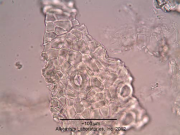Eucalyptus globulus (leaf)
(→USD) |
|||
| Line 1: | Line 1: | ||
=Introduction= | =Introduction= | ||
=Macroscopic Entries= | =Macroscopic Entries= | ||
| + | {{Macroscopy | source=United States Dispensatory (1918) | ||
| + | | description=The genus ''Eucalyptus'' was named in allusion to the operculum or | ||
| + | lid which covers the calyx until the stamens are fully formed. | ||
| + | The plants are evergreen and vary from | ||
| + | shrubs to trees of enormous height, some of them probably being the | ||
| + | highest trees known. Kerner gives the height as 140 to 152 meters. | ||
| + | |||
| + | The leaves frequently vary in shape and in position on both | ||
| + | young and mature trees; they are fixed vertically, and not horizontally | ||
| + | as the leaves of our trees, the petiole being twisted. The leaves | ||
| + | furthermore contain large oil-secreting reservoirs. The flowers are | ||
| + | arranged in cymes or axillary umbels and are devoid of petals; the | ||
| + | usually whitish stamens are inflexed in the bud and expand when the | ||
| + | operculum is removed, giving the name as already stated to the genus. | ||
| + | The fruit is a 3- to 6-celled truncated capsule, or pyxis. The seeds are | ||
| + | small and very numerous, the sterile ones predominating. | ||
| + | |||
| + | ''Eucalyptus globulus'' is one of the largest known trees, attaining | ||
| + | sometimes a height of 300 or even 350 feet, with a smooth, ash-colored | ||
| + | bark. The leaves attain a foot in length, and vary, according to age, | ||
| + | from a glaucous white to a bluish-green color. The flowers are large, | ||
| + | pinkish-white, axillary, occurring singly, or in clusters. Although its | ||
| + | wood is very resinous, hard, and durable, the tree is remarkable for the | ||
| + | rapidity of its growth, reaching, under favorable circumstances, fifty | ||
| + | feet of height in five or six years. | ||
| + | |||
| + | The leaves are described as follows: | ||
| + | |||
| + | Laminas lanceolately scythe-shaped, | ||
| + | from 8 to 30 cm. in length and from 2 to 7.5 cm. in breadth; summits | ||
| + | when present acute or acuminate; bases unequal, obtuse or more or less | ||
| + | rounded and connected with a twisted petiole from 5 to 35 mm. in | ||
| + | length; margins slightly uneven, revolute; coriaceous; both surfaces | ||
| + | varying from pale yellowish-green to grayish-green and more or less | ||
| + | glaucous, glabrous, glandular-punctate and with numerous small, | ||
| + | circular, brown dots of cork; veins of the first order anastomosing with | ||
| + | each other and forming a line nearly parallel with the margin; odor | ||
| + | slightly aromatic; taste aromatic, bitter, and cooling. | ||
| + | }} | ||
| + | |||
=Microscopic Entries= | =Microscopic Entries= | ||
| + | |||
| + | {{Macroscopy | source=United States Dispensatory (1918) | ||
| + | | description=Under the | ||
| + | microscope | ||
| + | sections of Eucalyptus show the upper and lower surfaces | ||
| + | with nearly similar cells, the outer walls being strongly cuticularized; | ||
| + | stomata occur on both surfaces, a region of palisade cells made up of | ||
| + | from 3 to 4 rows of cells occurring beneath each surface; among the | ||
| + | palisade cells occur large oil-secretion reservoirs, with a yellowish or | ||
| + | orange colored oily content; calcium oxalate crystals in cells of the loose | ||
| + | mesophyll in the form of rosette aggregates or monoclinic prisms | ||
| + | varying from 0.015 to 0.025 mm. in diameter. At the periphery of the | ||
| + | fibro-vascular bundles of the midrib and petiole occurs a more or less | ||
| + | interrupted circle of small groups of slightly lignified bast-fibers. | ||
| + | }} | ||
| + | |||
{{Microscopy | source=Elan M. Sudberg, Alkemist Laboratories | {{Microscopy | source=Elan M. Sudberg, Alkemist Laboratories | ||
| companyimage= AP-LOGO-Laboratories Crop - Copy.jpg | | companyimage= AP-LOGO-Laboratories Crop - Copy.jpg | ||
Revision as of 17:28, 7 January 2014
Contents |
Introduction
Macroscopic Entries
|
Microscopic Entries
|
|
HPTLC Entries
Other Points of Interest
Cite error: <ref> tags exist, but no <references/> tag was found

